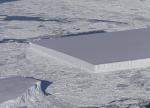Just like rainwater dissolves the bedrock on the Earth’s crust and form sinkholes, meltwater on a glacier’s surface can melt ice and form sinkholes too. Sinkholes on glaciers are called moulins, French for “mill”. Moulins form when summer meltwater streams on the surface of the glacier finds a crevasse or other weak spot in the ice and begins to pour down through the ice. As the water moves downward, its turbulence and heat creates a narrow, tubular and vertical shaft, up to 10 meters wide, that can go all the way down to the bottom of the glacier, hundreds of meters deep. Water entering a moulin eventually exits the glacier at base level where it acts like a lubricating fluid, that plays a big role on how fast the glacier flows. The melting water accelerates the glacier’s flow to the sea, where large chunks break off to form icebergs, leading to further ice loss by speeding disintegration of the ice sheet.

A hiker stands next to a massive moulin on Snowbird Glacier. Photo credit
Read more »© Amusing Planet, 2014.









Comments